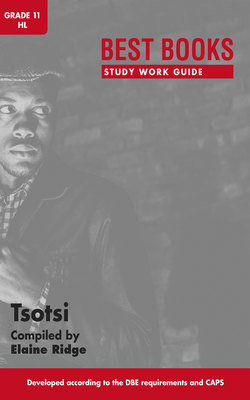Читать книгу Best Books Study Work Guide: Tsotsi Gr 11 HL - Elaine Ridge - Страница 4
На сайте Литреса книга снята с продажи.
Foreword to the Learners
ОглавлениеDear Grade 11 Learner
It is important to interact with the text when you read this novel.
As you read, ask yourself, for instance, what lies behind a character’s actions or words, or reflect on the descriptions used by the author and the insights they provide into the emotions and feelings of the characters. Here is one example:
| His name was Gumboot Dhlamini and he had been chosen. But he never knew until it was too late. They gave him no warning.Gumboot was a man. Measured in hope he stood in his shoes tall amongst men, but even barefoot on a day back with an empty belly and a chesty laugh sounding the vastness of his humour as he walked into the city so that those who heard him looked up at him, even then Gumboot had stood as high as a head in heaven.‘Maxulu,’ he had said a thousand miles away, standing on the side of the road with his wife, ‘Maxulu, I will be back.’ (p. 9)Extract from Tsotsi, Athol Fugard, Cover2Cover Books published by licence from Jonathan Ball Publishers, 2015. |
Questions you could ask are
What has Gumboot been chosen for? A possible answer is that he is to be the victim of ruthless action. The words “too late” and “no warning” (p. 9) suggest his powerlessness and the finality of the action.
How do the descriptions used by the author help us to understand the kind of person Gumboot is? They create a sense of his personal strength and optimism in the face of hardship. There is a contrast between his present good fortune (he is wearing shoes and is confident) and the hard times he has faced when there was little money for food (“empty belly”) and his health suffered (“chesty laugh”), but it is clear that even in the worst of times, Gumboot is a good man (“stood as high as a head in heaven”).
Why does the author remind us of Gumboot’s farewell words to his wife? He wishes to emphasise that Gumboot is a man whose word can be trusted.
The pre-reading questions invite you to predict what will happen in the chapter. To do that, you need to combine what you know about the setting, the events so far, and the characters, with your own experience. This process is sometimes described as informed guessing.
The reading questions are there to help you notice key features. Just jot down your answers in note form. It is important not to interrupt the flow of your reading. Of course, if you find that you are not sure what is happening, you may have to re-read (skim or scan) to find what you missed or did not notice when you read that part.
The post-reading questions will help you to see whether you have understood the characters’ motives and the effect of their actions, and whether you have remembered key incidents. Questions will sometimes ask you to give information that is explicitly given in the text. At other times, you will need to read between the lines (interpret) and apply information or insights to other situations. You may also be asked to respond critically or to give your opinion. Look at the chart on page 45 for some question examples.
There are also opportunities for you to try your hand at answering more formal contextual questions. These will test how well you “know” the book and are able to give close attention to a relatively short section of it.
The information in the first part of the novel is there to help you.
The publisher and compiler
